1996 PONTIAC GRAND-AM key
[x] Cancel search: keyPage 112 of 356

Charging System Indicator Light
The charging system
indicator light will come on
briefly when
you turn on the
ignition, but the engine
is
not running, as a check to
show you it is working.
Then it should go out. .. 1.
. I -1
If it stays on when your engine is running, OF comes on
while you are driving, you may have a problem with the
electrical charging system. It could indicate that you
have a loose generator drive belt or another electrical
problem. Have it checked right away. Driving while this
light
is on could drain your battery.
If you mast drive a short distance with the light on, be
certain to turn off all your accessories, such as themdio
and
air conditioner,
Brake System Warning Light
Your Pontiac’s hydraulic brake system is divided into
two parts. If one part isn’t working, the other part can
still w’ork and
stop you. For good braking, though, you
need both
parts workmg well.
If the warning light comes on, there could be a brake
problem. Have your brake system inspected right away.
BRAKE
This light should come ow
briefly when you turn the
ignitibn key
to RUN. If it
doesn’t come on then, have
it fixed so it will be ready to
warn
you if there’s a
problem,
If the light .comes on while you are driving, pull off the
road and stop carefully. You may notice that the pedal is
harder to push. Or, the pedal may go closer to the floor,
It may take longer to stop. If the light is still on, have the
vehicle towed €or
service, (See “Towing Your Vehicle”
in the Index.)
2-56
ProCarManuals.com
Page 114 of 356
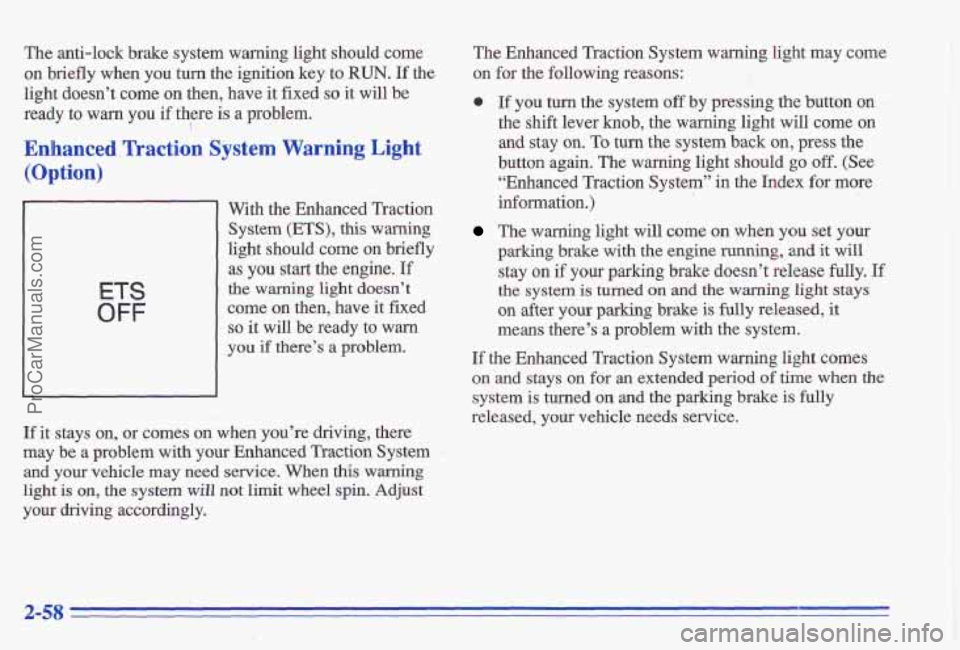
The anti-lock brake system warning light should come
on briefly when
you turn the ignition key to RUN. If the
light doesn’t come
on then, have it fixed so it will be
ready to warn you if there is a problem.
Enhanced,T’raction Syst’em Warning Light
(Option)
!
ETS
OFF
With the Enhanced Traction
System
(ETS), this warning
light should come on briefly
as
you start the engine. If
the warning light doesn’t
come on then, have it fixed
so it will be ready to warn
you if there’s a problem.
If it stays on, or comes on when you’re driving, there
may
be a problem with your Enhanced Traction System
and
your vehicle may need service. When this warning
light is on, the system will not limit wheel spin. Adjust
your driving accordingly. The Enhanced Traction
System warning light may come
on for the following reasons:
0 If you turn the system off by pressing the button on
the shift lever
knob, the warning light will come on
and stay an. To turn the system back on, press the
button
again. The warning light should go off. (See
“Enhanced Traction System” in the Index for more
information.)
The warning light will come on when you set your
parking brake with the engine running,
and it will
stay on if your parking brake doesn’t release fully. If :‘.
the system is turned on and the warning light stays
on after your parking brake is fully released, it
means there’s a problem with the system.
If the Enhanced Traction System warning light comes
on and stays on
for an extended period of time when the
system is turned on and the paking brake is fully
released, your vehicle needs service.
ProCarManuals.com
Page 115 of 356
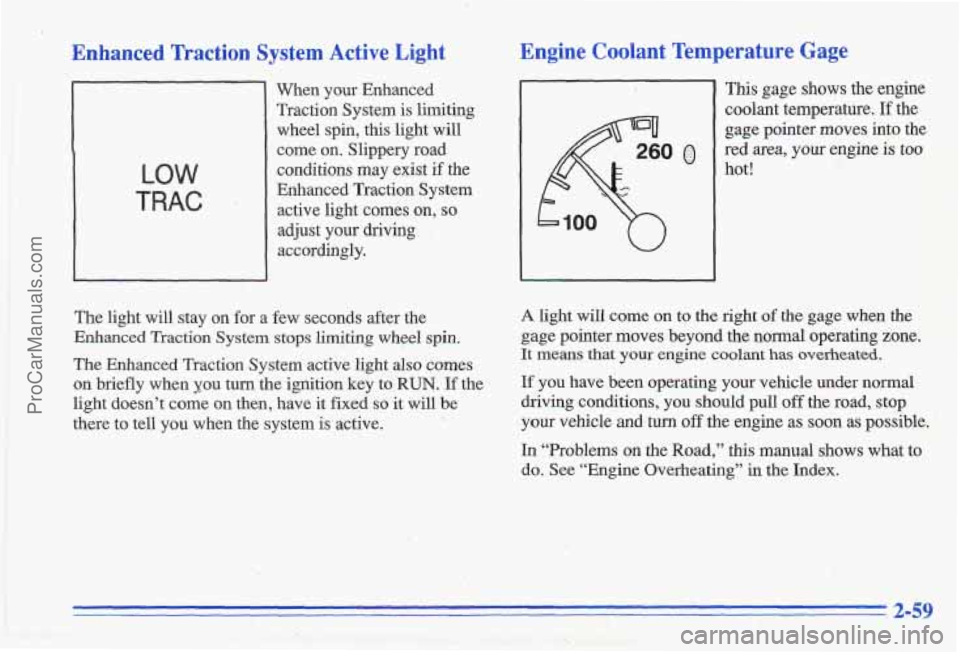
Enhanced Traction System Active Light
LOW
TRAC
When your Enhanced Traction System is limiting wheel spin, this light will
come on. Slippery road
conditions may exist
if the
Enhanced Traction System
active light comes on,
so
adjust your driving
accordingly.
The light
will stay on for a few seconds after the
Enhanced Traction System stops limiting wheel spin.
The Enhanced Traction System active light also comes
on briefly when you turn the ignition key to RUN. If the
light doesn’t come on then, have it fixed
so it will be
there to tell you when the system is active.
Engine Coolant Temperature Gage
This gage shows the engine
coolant temperature.
If the
gage pointer moves into the
red area,
your engine is too
hot!
A light will come on to the right of the gage when the
gage pointer moves beyond the normal operating zone.
It means that
your engine coolant has overheated.
If you have been operating your vehicle under normal
driving conditions, you should pull
off the road, stop
your vehicle and turn off the engine as soon as possible.
In “Problems on the Road,” this manual shows what to
do. See “Engine Overheating” in the Index.
2-59
ProCarManuals.com
Page 117 of 356

I NOTICE:
If you keep driving your vehicle with this light
on, after a while, your emission controls may nmot
work as well, your fuel economy may not be as
good and your engine may not run as smoothly.
This could lead to costly repairs that may not be
covered by your warranty.
This light should come on, as a check to show you it is
working, when the ignition
is on and the engine is not
running.
If the light doesn’t come on, have it repaired.
This
light will also come on during a malfunction’ in one
of two ways:
0 Light Flashing -- A misfire condition has been
detected.
A misfire increases vehicle emissions and
may damage the emission control system on your
vehicle. Dealer or qualified service center diagnosis
and service is required.
0 Light On Steady -- An emission control system
malfunction has been detected on your vehicle.
Dealer or qualified service center diagnosis and
service may be required.
If the Light Is Flashing
The following may prevent ml
your vehicle:
0 Reduce vehicle speed.
0 Avoid hard accelerations.
0 Avoid steep uphill grades.
e serious damage to
i
If towing a trailer, reduce the amount of cargo being
hauled as-soon as it is possible.
If the light stops flashing and remains on steady, see “If
the Light Is On Steady” following.
If the light continues to flash, when it is safe to do so,
stop the vehicle. Put your vehicle in PARK (P). Turn the
key off, wait at least 10 seconds and restart the engine.
If the light remains on steady, see “If the Light Is On
Steady” following.
If the light is still flashing follow the
previous, steps, and drive the vehicle to
your dealer or
qualified service center for service.
2-61
ProCarManuals.com
Page 120 of 356
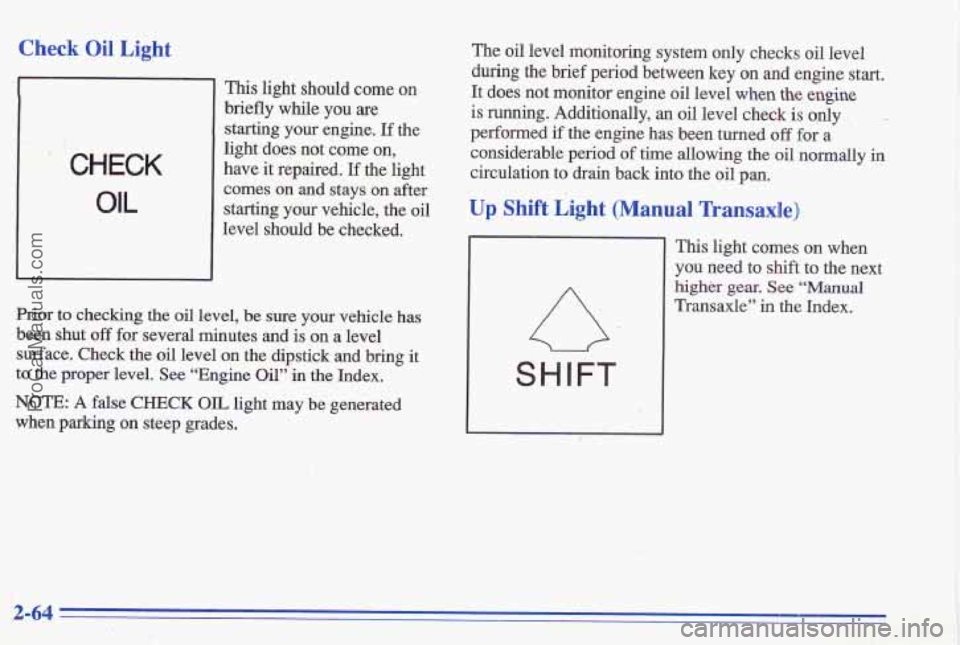
Check Oil Light
. CHECK
OIL
This light should come on
briefly while you
are
starting your engine. If the
light does not come on,
have
it repaired. If the light
comes on and stays
on after
starting your vehicle, the oil
level should be checked.
Prior to checking the
oil level, be sure your vehicle has
been shut off for several minutes and is on a level
surface. Check the oil level on the dipstick and
bring it
to the proper level. See “Engine
Oil” in the Index.
NOTE: A false CHECK OIL light may be generated
when parking
on steep grades. The
oil level monitoring system only checks
oil level
during the brief period between key
on and engine start.
It does not monitor engine
oil level when the engine
is running. Additionally, an oil level check is only
performed
if the engine has been turned off for a
considerable period
of time allowing the oil normally in
circulation
to drain back into the oil pan.
Up Shift Light (Manual Transaxle)
This light comes on when
you need to shift to the next
higher gear. See
“Manual
Transaxle” in the Index,
2-64
ProCarManuals.com
Page 121 of 356

Passlock Warning Light Fuel Gage
THEFT
SYS
This light will come on
briefly when you turn the
key towards the START
position. The light will stay
on until the engine starts.
W
(3
Your fuel gage tells you
about how much fuel you
have left, when
the ignition is
on. When the indicator nears
EMPTY (E), you still have a
little fuel left, but you should
get more soon.
An amber
light
will come on below the
gage when the fuel
tank is
near
EMPTY (E).
If the light flashes,. the Passlock system has entered a
tamper mode. If the vehicle fails to start, see "Passlock"
in the Index.
If the light comes on continuously while driving and
stays on, there may
be a problem with the Passlock
system. Your vehicle will not be protecteil
by Passlock,
and you should see your dealer.
J
Here are four things that some owners ask about. None
of these show a problem with
your fuel gage:
At the service station, the gas pump shuts off b'efore
the gage reads
FULL (F). ' I
It takes a little more or less fuel to fill up than the gage
indicated. For example,
the gage may have indicated
the
tank was half full, but it actually took a little more
' or less than half the tank's capacity to fill the tank.
The gage moves a little when you turn a, corner or
The gage doesn't go back to EMPTY (E) when you
speed up.
turn
off the ignition.
2-65
ProCarManuals.com
Page 150 of 356
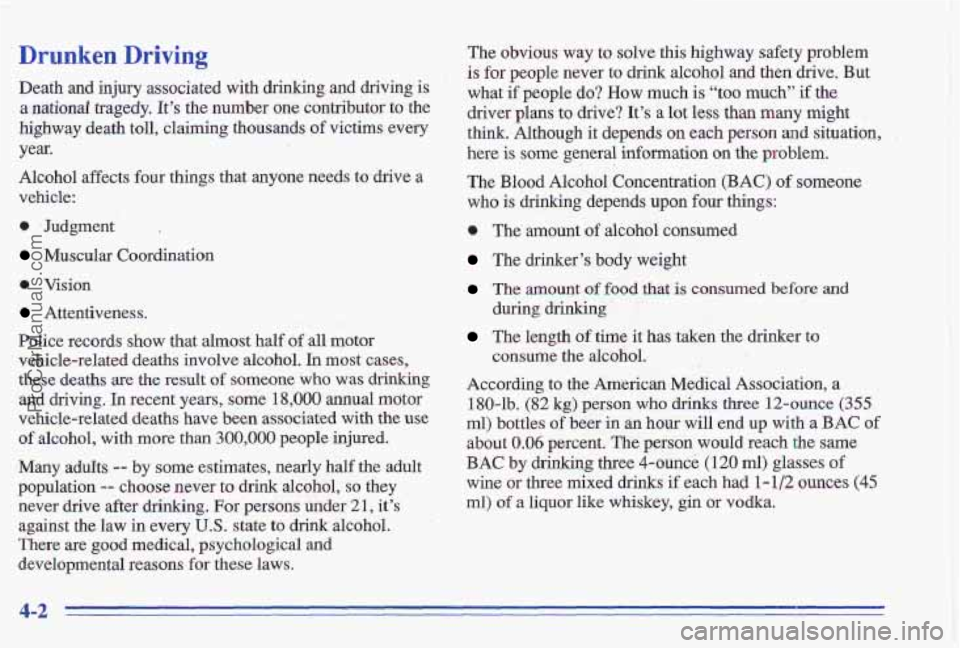
Drunken Driving
Death,'and injury associated with drinking and drivingis
a national tragedy. It's the number one contributor to the
highway death
toll, claiming thousands of victims every
year.
Alcohol affects four things that anyone needs to-drive
a
vehicle:
0 'Judgment
Muscular Coordination :.2.
.',, * Vision
Attentiveness.
Police records
show that almost half of dl motor
vehicle-related deaths involve alcohol.
In most cases,
these deaths are the result of someone who was drinking
and driving. In recent years, sortle 18,000 annual motlor
vehicle-related deaths have been associated with the use
of alcohol, with more
than 300,000 people injured.
.Many adults -- by some estimates, nearly half the adult
population
-- chbose never to drink alcohol, so they
never
tirive after drinking. For persons under 21, it's
against
the law in every U.S. state to drink alcohol. ,
There are good medical, psychological and
developmental reasons
for these laws.
The obvious way to solve this highway safety problem
is for people never to
drink alcohol and then drive. But
what if people do? How much is "too much" if the
driver plans to drive? It's a lot less than many might
think. Although it depends
on each person and situation,
here is some general information on the prbblem.
The Blood Alcohol Concentration
(BAC) of someone
who'is drinking depends upon
four things:
e The amount of alcohol consumed
The drinker's body weight
The amount of food 'that is consumed before and
during drinking
consume the alcohol.
The length of time it 'has taken the drinker to
According to the
American. Medical Association, a
180-lb. (82 kg) person who elrinks three 12-ounce (355
nil) bottles of beer in an hour will end up with a BAC of
about 0.06 percent. The person would reach the same
BAC by drinking three 4-ounce (120 ml) glasses of
wine or three mixed drinks if each had 1-1/2 ounces (45
ml) df a liquor like whiskey, gin or vodka,
I.
ProCarManuals.com
Page 178 of 356
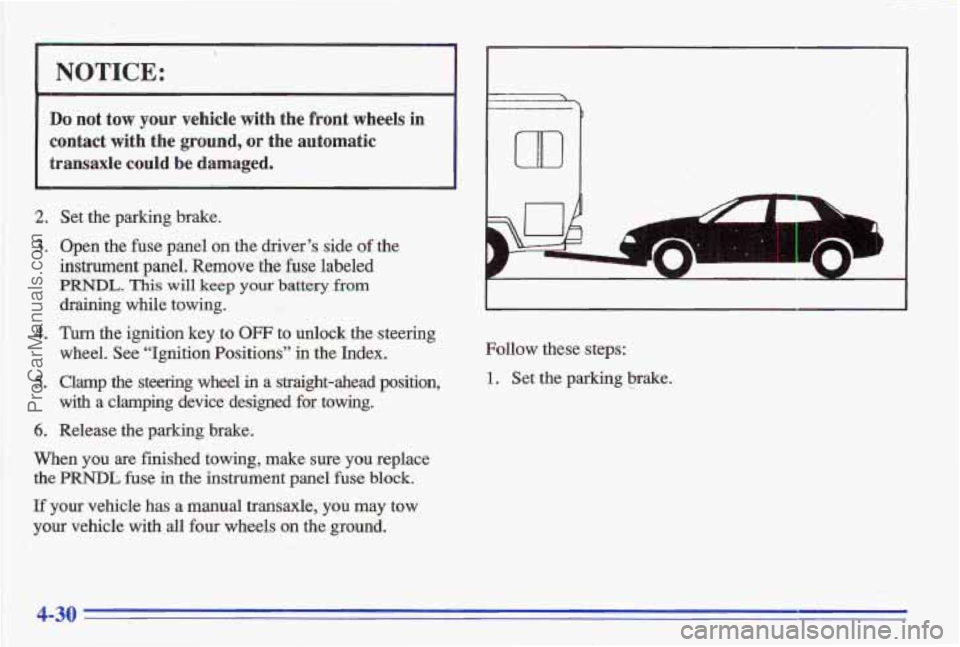
NOTICE:
Do not tow your vehicle with the front wheels in
contact with the
ground, or the automatic
transaxle
could be damaged.
2. Set the parking brake.
3. Open the fuse panel on the driver’s side of the
instrument
panel. Remove the fuse labeled
PRNDL. This will keep your battery from
draining while towing.
wheel. See “Ignition Positions”
in the Index.
with
a clamping device designed for towing.
4. Turn the ignition key to OFF to unlock the steering
5. Clamp the steering wheel in a straight-ahead position,
6. Release the parking brake.
When you are finished towing, make sure you replace
the PRNDL fuse in the instrument panel fuse block.
If your vehicle has a manual transaxle, you may tow
your vehicle with all four wheels on the ground.
m
Follow these steps:
1. Set the parking brake. .
4-30
ProCarManuals.com